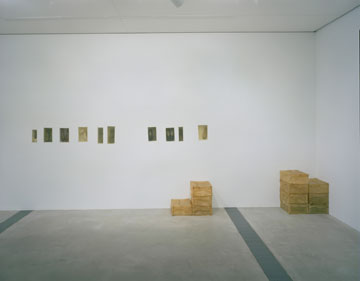
Doris Salcedo, "Atrabiliarios," 1992-93. Photo: Robert Pettus. Courtesy the Pulitzer Foundation for the Arts.
When I learned that Doris Salcedo was being featured in Art21’s episode on Compassion, I couldn’t imagine a more appropriate artist to represent this theme. However to me, Salcedo goes beyond feeling compassion for the victims she represents in her work to being completely enveloped in their reality. By doing so, she’s able to give a voice to those who were silenced. This is especially strong in her work, Atrabiliarios, which powerfully illustrates what is left behind from the “disappeared ones” — empty shoes and unhealed wounds. This work is one of the few owned by the Pulitzer Foundation for the Arts, and was featured in our exhibition Portrait/Homage/Embodiment. The shoes, which are recessed in niches that are covered by roughly-sewn animal skins, are abstracted representations of individuals who have “disappeared” as the result of political violence in Colombia. The power of the work comes from Salcedo’s strong and immediate connection with her subject’s world.
While contemplating what to write for this post, I remembered that Salcedo gave a talk in St. Louis back in 2002, when the work was purchased. Looking through the transcript, she describes how you cannot understand a situation by analyzing it from a comfortable distance—something I think we’re all guilty of every time we open a newspaper. To fully connect with a situation she asks you to go beyond analysis and be “in the world” — to delve into the history and the lives of those involved. She emphasized that she considers her art to be “impotent” in actually changing the circumstances behind these terrible stories. However, the ability of her work to communicate is not only strong, but essential in continuing the memory of the victim. When a viewer contemplates Salcedo’s art, the pain of the victim being represented reaches out and connects with each viewer’s own memories of pain. This personal and private interaction with the work elicits compassion from the viewer and in that moment, connects him or her to the victim.
In a series of timely posts on Modern Art Notes, Tyler Green discusses the use of art as a means for understanding the difficult subject of torture. I feel that this sentence in particular can be applied to Salcedo’s approach to her work: “Perhaps because they embrace ambiguity rather than reject it, artists often excel at embracing emotionally and intellectually difficult subjects.” Through the openness of her work, Salcedo is able to communicate a fuller reality of the individual she represents, beyond newsprint or a CNN ticker. The violence inflicted upon the victims, the materials left behind, the artist’s position and that of the viewer — all of these combine to create a powerful cross-section of experiences and emotions, resulting in a stronger sense of understanding and compassion with those represented in the work.
Rachel Gagnon Craft is Communications and Web Manager at the Pulitzer Foundation for the Arts in St. Louis, MO.


